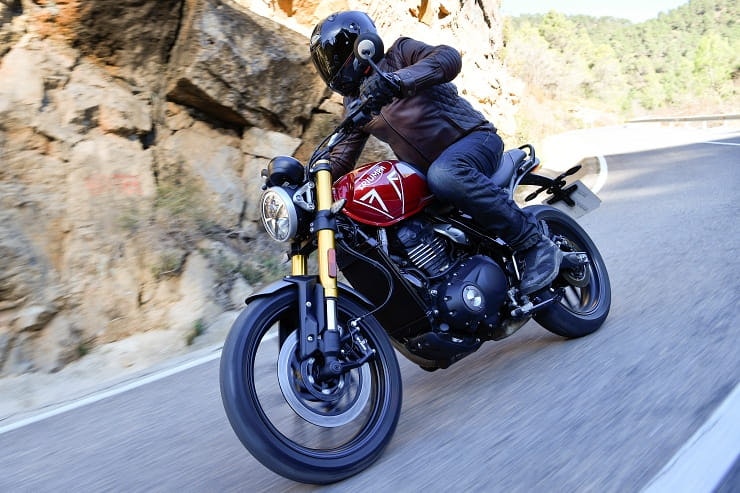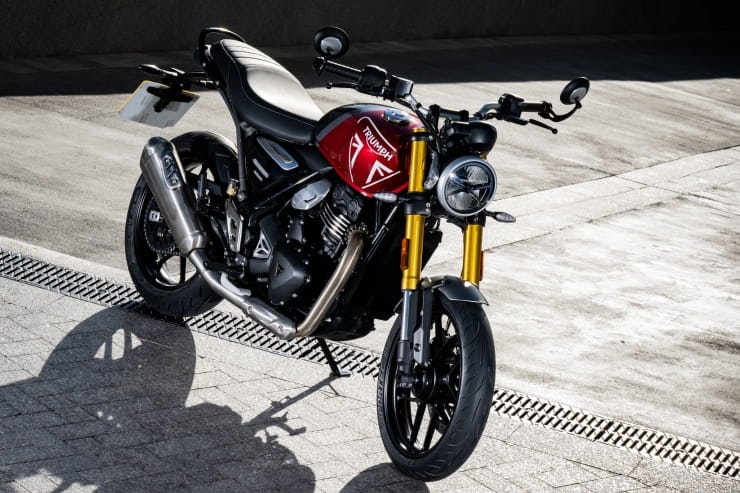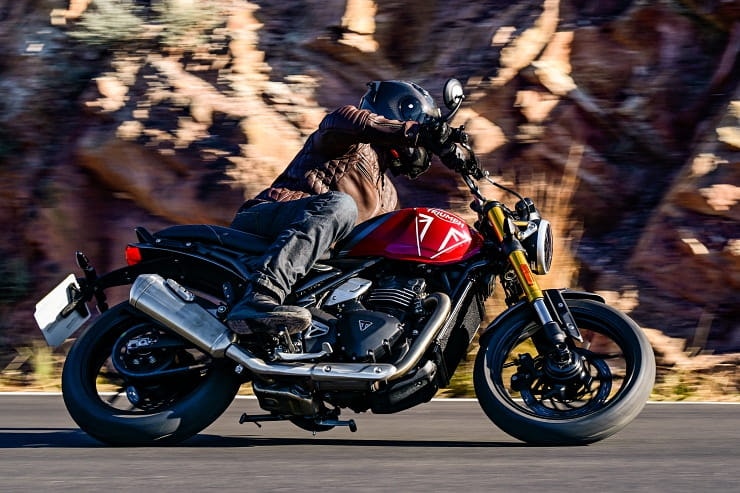Technical Review: Ben Purvis
Press launch review: Martin Fitz-Gibbons
Price: £4995 | Power: 39.5bhp | Weight: 170kg | Overall BikeSocial Rating: 5/5
For more than a decade Triumph has been pursuing the goal of creating an entry-level model range to entice new customers to its fold – and after some false starts the result is finally here in the form of the Speed 400.
Developed and built in cooperation with India’s Bajaj, the Speed 400 is the debut model for an entirely new platform built around a 398cc single-cylinder engine. With it, Triumph will take on not only retro-styled rivals like Royal Enfield’s HNTR 350, a key competitor in the Indian market, as is the Honda CB350 and upcoming Harley-Davidson X440, but also the likes of BMW’s G310R and KTM’s 390 Duke in Europe and elsewhere.
This is no reworked version of another company’s bike, as seen with the likes of Harley-Davidson’s Asian-market X350, which is derived from a Qianjiang/Benelli design, but a clean-sheet design aimed at the global market. While partner Bajaj will build some of them in its Indian plants, they’ll also come from Triumph’s existing factories in Thailand and Brazil.
Build quality and up-close details look phenomenally good for the money
Twice the power of other retro rivals thanks to all-new, liquid-cooled single
Impressive suspension, brakes and handling
Short gearing makes the motor feel busy at motorway speeds
Throttle response can feel a little abrupt at walking pace in first gear
Analogue/LCD dash a step behind the latest tech when it comes to connectivity
2024 Triumph Speed 400 and Scrambler 400X Review
For 2024 Triumph has developed and built in cooperation with India’s Bajaj not one but two new motorcycle using an entirely new platform built around a 398cc, single-cylinder engine - the Speed 400 and Scrambler 400X. Our man, Martin Fitz-Gibbons has been to ride both of them back-to-back for your delectation.
2024 Triumph Speed 400 price
The Triumph Speed 400 costs an extremely reasonable £4995 on the road and is in UK dealers right now (February 2024). Three colours are available – Carnival Red, Phantom Black and Caspian Blue – all costing the same amount.
How does the Speed’s price compare? It’s more than the ultra-popular Royal Enfield HNTR 350 (from £3899, depending on colour), but the Speed is in a completely different league when it comes to power, weight, technology, excitement and sophistication. Beneath the retro styling, the Speed 400 is far closer in its modern dynamic and tech levels to KTM’s 390 Duke, which costs £5699. The Triumph also undercuts the Husqvarna Vitpilen 401 (£5599) and even the substantially less-convincing BMW G310R (from £5190).
Considering finance? Put down a £999 deposit and you can ride away on a Speed 400 for just £67.84 a month (quote on 2nd Feb 2024). Absolute bargain.
2024 Triumph Speed 400 Engine & Performance
Coming in at 398cc, the new single-cylinder Triumph engine – known as the ‘TR-series’ to hark back to previous singles in the firm’s history – punches at a substantially higher level than most of its direct rivals in India. Triumph claims 40PS (39.5bhp) at 8000rpm from the DOHC, liquid-cooled motor, which uses similar tricks to the Bonneville’s 900cc and 1200cc twins to hide its modernity, with handsome machined fins on the cylinder and a largely hidden radiator to give the appearance of an air-cooled design, plus a twin-skinned exhaust that cleverly hides the front silencer and catalyst to look like it run straight from the cylinder head to the end can.
On the road the Speed 400’s motor strikes a fine balance between retro and modern. It’s mostly very smooth, thanks to a counter-rotating balance shaft, but not so overly refined that it feels anonymous, insipid or dull. With only 398cc it doesn’t exactly punch bombastically, but power builds politely at first accompanied by a warm, rich exhaust note. Enthusiasm picks up sharply around 6000rpm, then charges through the revs until a rather sudden limiter interrupts at 9500rpm. The torque-assist clutch is light, and the gearbox shifts easily and cleanly.
Gearing is short. Around town first gear is used up so quickly it’s barely needed, while at motorway cruising speed the motor’s still spinning around 7000rpm even in top gear. It’s not vibey – mirrors stay clear at 70mph – but you’re aware it feels busy. Push on any faster and it does start to get tingly.
Our only other mild gripe is an occasional abruptness at very slow speed in first gear when picking up the throttle from completely shut to slightly open. It doesn’t feel like snatchy fuel injection, but something else causes an unintentionally sharp response, meaning you need to slip the clutch to guarantee a seamless transition.
The throttle is a full ride-by-wire system, but there are no riding modes to choose from. Traction control is standard, and can be switched off at a standstill.
2024 Triumph Speed 400 Handling, weight and suspension
The Speed 400 uses what Triumph calls a ‘hybrid’ frame: made from tubular steel, but neither a regular perimeter nor a classic backbone in design. At the back of the bike there’s a bolt-on steel subframe and a rather fetching cast aluminium swingarm. Wheelbase is a short 1377mm, while rake is a fairly steep 24.6 degrees of rake and trail just 102mm. Combine all that with a kerb weight of just 170kg, and the Speed 400 relishes showing off its surprisingly sporty handling on the tight, twisty mountain roads near Valencia where the world launch is held.
Cast wheels are 17in at both ends, wearing excellent Metzeler M9RR sports tyres in 110/70 and 150/60 sizes. The sizes work perfectly, matching the proportions of the bike so it doesn’t look either under or over-tyred, while also letting the Speed whip its way through turns and change direction with glorious ease.
Forks are a chunky 43mm upside-down design and feature Big Piston internals but are also completely unadjustable. Rear suspension is a linkage-free monoshock with a stepped preload adjuster. Suspension action feels remarkably good at both ends, managing to give a forgiving ride when crashing over speed bumps and potholes in town, but also keeping the chassis composed when the Speed’s having its neck wrung on twisty roads. Often affordable small-cc bikes feel hopelessly under sprung, but the Speed’s suspension copes astonishingly well even with a 90kg (14 stone) rider on board.
2024 Triumph Speed 400 Comfort & Economy
The Speed 400 isn’t as tiny as you might first assume. An average sized (5ft 9in) person fits with surprising ease – alright, the ergonomics are a smidge more squished up than a larger capacity bike, but it certainly doesn’t feel like a miniscule, little pixie of a thing.
However, shorter, or less-confident riders definitely won’t feel overwhelmed either. Claimed seat height is 790mm (31.1in), but the Speed 400 is so slim and light that riders of all sizes will feel right at home on it. Bad news if you do want to lower it, however: there isn’t a lower seat option, while the linkage-free shock design means you can’t simply chuck in some different dog bones to drop the back end.
Officially the Speed 400 has a rated fuel economy of 80.7mpg. Multiplied by the claimed 13-litre fuel tank, that gives a theoretical range of 230 miles. We didn’t get a chance to measure true fuel economy during the riding launch, but even after a day’s rather, ahem, “exuberant” use the clocks still estimated almost 75mpg.
The clocks combine an analogue speedo with a small LCD panel showing revs, gear position, fuel gauge and trip meter, including a remaining fuel range estimator. The vertical bar-graph rev counter is tiny and easily lost at a quick glance. Personally, I’d prefer a digital speedo as they’re faster to read, but the Speed’s dial is admittedly a better match for the bike’s retro image.
A USB-C power socket lies to the right of the clocks, though there’s no Bluetooth phone connectivity, for riders who like that kind of thing.
2024 Triumph Speed 400 brakes
Up front the Speed 400 features a single 300mm disc and a four-piston ByBre radially mounted caliper. Braided lines are standard, as is a simple (non-lean-sensitive) ABS system which, unlike the Scrambler 400 X, can’t be deactivated. At the back there’s a 230mm disc and a single-piston caliper.
Stopping power is plentiful, and there’s a strong bite and great feel through the unadjustable lever. Even braking hard into tight mountain corners, the Speed’s chassis stays nice and flat, with impressive support from the forks. It’s a great setup that feels way better than you’d expect to find on a sub-£5k bike.
2024 Triumph Speed 400 Rivals
Royal Enfield HNTR 350 | Price: £3899
Handsome, simple, and obscenely popular, but not even close to the Speed 400’s level when it comes to performance, technology or modernity. Half as much power and heavier too, though it is also £1100 cheaper, which will count for a lot.
Power/Torque: 20bhp/20lb-ft | Weight: 181kg (kerb)
KTM 390 Duke | Price: £5699
Couldn’t be more different in looks, but the 390 Duke closely matches the Speed in performance. KTM boasts a touch more power with a more aggressive delivery, a little less weight, plus higher-spec suspension and electronics. Also manufactured by Bajaj in India.
Power/Torque: 44bhp/29lb-ft | Weight: 165kg (kerb)
Husqvarna Vitpilen 401 | Price: £5599
Built on the same platform as KTM’s 390, similarly updated for 2024 with a more powerful 399cc motor. Like the KTM there’s loads of tech and gadgets, but the Husky’s styling is a shade more old-school, making it arguably the closest match for a Speed 400.
Power/Torque: 44bhp/29lb-ft | Weight: 165kg (kerb, est)
2024 Triumph Speed 400 Verdict
Considering Triumph have never made a single-cylinder engine or a sub-600cc road bike before, the Speed 400 is an absolutely phenomenal A2-class debut. From a distance, it looks fantastic. Up close, the detailing is somehow even more impressive. And to ride, it manages to combine being welcoming, friendly and manageable for newer riders, while also being a hoot to buzz along on for veterans.
It most definitely is not a case of style over substance, nor is it a quick cash-in where a premium European badge has been cynically slapped on a budget bike. The Speed looks like a Triumph, and more importantly it rides exactly like a small-cc Triumph should.
As far as areas for improvement go, it’s only really the bike’s short gearing that has us scratching our heads. It’s not really an issue if you’re riding around town (other than an occasionally over-keen response in first gear) or on tight, twisty B-roads, where the eager acceleration is well worth having. But if you want to sit at higher speeds, the busy engine speeds might soon get a bit tiresome. Perhaps a sprocket change would help; we’ll have to wait for owners to start modifying their bikes to find out.
Otherwise the Speed 400 is an absolute gem. Right now it’s easily the best new bike you can buy for less than £5000. It’s not just a great bike for A2-licence riders, it’s a great bike full stop.
If you’d like to chat about this article or anything else biking related, join us and thousands of other riders at the Bennetts BikeSocial Facebook page.
2024 Triumph Speed 400 Technical Specification
Looking for motorcycle insurance? Get a quote for this motorbike with Bennetts bike insurance
What is MCIA Secured?
MCIA Secured gives bike buyers the chance to see just how much work a manufacturer has put into making their new investment as resistant to theft as possible.
As we all know, the more security you use, the less chance there is of your bike being stolen. In fact, based on research by Bennetts, using a disc lock makes your machine three times less likely to be stolen, while heavy duty kit can make it less likely to be stolen than a car. For reviews of the best security products, click here.
MCIA Secured gives motorcycles a rating out of five stars (three stars for bikes of 125cc or less), based on the following being fitted to a new bike as standard:
A steering lock that meets the UNECE 62 standard
An ignition immobiliser system
A vehicle marking system
An alarm system
A vehicle tracking system with subscription
The higher the star rating, the better the security, so always ask your dealer what rating your bike has and compare it to other machines on your shortlist.


